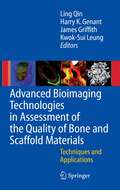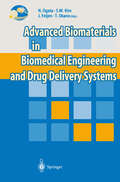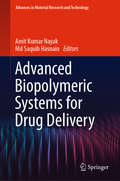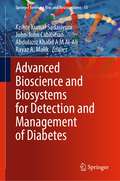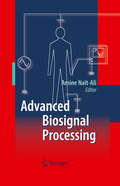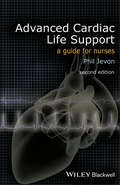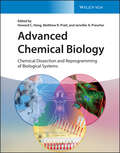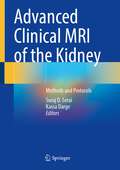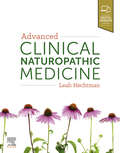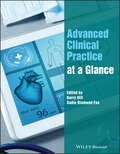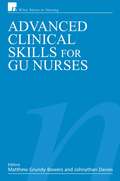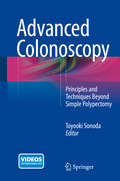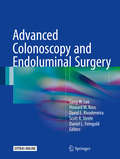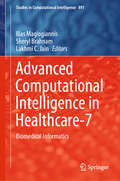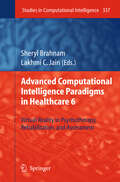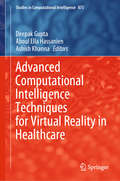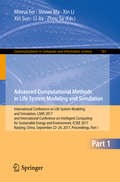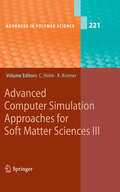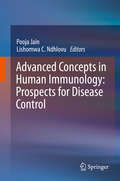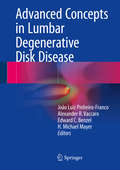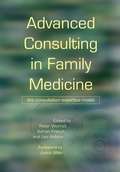- Table View
- List View
Advanced Bioimaging Technologies in Assessment of the Quality of Bone and Scaffold Materials: Techniques and Applications
by L. Qin Harry K. Genant J. F. Griffith K. S. LeungThis book provides a perspective on the current status of bioimaging technologies developed to assess the quality of musculoskeletal tissue with an emphasis on bone and cartilage. It offers evaluations of scaffold biomaterials developed for enhancing the repair of musculoskeletal tissues. These bioimaging techniques include micro-CT, nano-CT, pQCT/QCT, MRI, and ultrasound.
Advanced Biomaterials in Biomedical Engineering and Drug Delivery Systems
by Naoya Ogata Sung W. Kim Jan Feijen Teruo OkanoFirst of all, I would like to share the great pleasure of the successful five-day symposium with every participant in the 5th Iketani Conference which was held in Kagoshima from April1S (Tuesday) to 22 (Saturday), 1995. Outstanding speakers enthusiastically presented their up-to-the-minute results. Relatively little time was allotted for each presentation to ensure asdnuch time· as possible for intensive discussions on the particular topics that had just been p~esented: I was delighted to see that the lectures were of high quality, and the discu,ssionswere lively, exciting, and productive in a congenial atmosphere. We also had 92 papers in the poster ·session, in which young (and relatively young) scientists made every effort to present the novel results of their research in advanced biomaterials and drug delivery systems (DDS). I believe some of the research is most promising and will become noteworthy in the twenty-first century. It was a privilege for me to deliver a lecture at the special session of the symposium. In my introductory remarks, I pointed out five key terms in multifaceted biomaterials research: materials design, concept or methodology, devices, properties demanded, and fundamentals. I am confident that innovative progress in device manufacturing for end-use, e.g., artificial organs, vascular grafts, and DDS, can be brought about only through properly designed advanced materials that exhibit the desired functionality at the interface with any living body.
Advanced Biopolymeric Systems for Drug Delivery (Advances in Material Research and Technology #133)
by Amit Kumar Nayak Md Saquib HasnainThis book discusses the recent innovations in the development of various advanced biopolymeric systems, including gels, in situ gels, hydrogels, interpenetrating polymer networks (IPNs), polyelectrolyte complexes (PECs), graft co-polymers, stimuli-responsive polymers, polymeric nanoparticles, nanocomposites, polymeric micelles, dendrimers, liposomes and scaffolds. It also examines their applications in drug delivery.
Advanced Bioscience and Biosystems for Detection and Management of Diabetes (Springer Series on Bio- and Neurosystems #13)
by Kishor Kumar Sadasivuni John-John Cabibihan Abdulaziz Khalid A M Al-Ali Rayaz A. MalikThis book covers the medical condition of diabetic patients, their early symptoms and methods conventionally used for diagnosing and monitoring diabetes. It describes various techniques and technologies used for diabetes detection. The content is built upon moving from regressive technology (invasive) and adapting new-age pain-free technologies (non-invasive), machine learning and artificial intelligence for diabetes monitoring and management. This book details all the popular technologies used in the health care and medical fields for diabetic patients. An entire chapter is dedicated to how the future of this field will be shaping up and the challenges remaining to be conquered. Finally, it shows artificial intelligence and predictions, which can be beneficial for the early detection, dose monitoring and surveillance for patients suffering from diabetes
Advanced Biosignal Processing
by Amine Naït-AliGenerally speaking, Biosignals refer to signals recorded from the human body. They can be either electrical (e. g. Electrocardiogram (ECG), Electroencephalogram (EEG), Electromyogram (EMG), etc. ) or non-electrical (e. g. breathing, movements, etc. ). The acquisition and processing of such signals play an important role in clinical routines. They are usually considered as major indicators which provide clinicians and physicians with useful information during diagnostic and monitoring processes. In some applications, the purpose is not necessarily medical. It may also be industrial. For instance, a real-time EEG system analysis can be used to control and analyze the vigilance of a car driver. In this case, the purpose of such a system basically consists of preventing crash risks. Furthermore, in certain other appli- tions,asetof biosignals (e. g. ECG,respiratorysignal,EEG,etc. ) can be used toc- trol or analyze human emotions. This is the case of the famous polygraph system, also known as the “lie detector”, the ef ciency of which remains open to debate! Thus when one is dealing with biosignals, special attention must be given to their acquisition, their analysis and their processing capabilities which constitute the nal stage preceding the clinical diagnosis. Naturally, the diagnosis is based on the information provided by the processing system.
Advanced Cardiac Life Support: A Guide for Nurses
by Philip JevonIn the event of an adult cardiac arrest, it is essential to be able to respond rapidly, providing safe and effective care. This new and updated edition of Advanced Cardiac Life Support provides the theoretical background to resuscitation as well as explaining the essential resuscitation skills required to manage an adult cardiac arrest- from the time it occurs until subsequent transfer to the ICU. The emphasis is on the prevention of cardiac arrest with detailed information on the management of peri-arrest arrhythmias and acute coronary syndromes. Advanced Cardiac Life Support also discussed ethical and legal issues, record keeping, dealing with bereavement, audit, equipment and training- providing an essential quick reference tool for nurses and health care professionals. An evidence-based approach to emergency care based on the latest Resuscitation guidelines A succinct yet comprehensive guide to the management of cardiac arrest Written by an experienced resuscitation training offer who is also a qualified nurse and former CCU Charge Nurse
Advanced Cardiac Life Support: A Guide for Nurses
by Philip JevonIn the event of an adult cardiac arrest, it is essential to be able to respond rapidly, providing safe and effective care. This new and updated edition of Advanced Cardiac Life Support provides the theoretical background to resuscitation as well as explaining the essential resuscitation skills required to manage an adult cardiac arrest- from the time it occurs until subsequent transfer to the ICU. The emphasis is on the prevention of cardiac arrest with detailed information on the management of peri-arrest arrhythmias and acute coronary syndromes. Advanced Cardiac Life Support also discussed ethical and legal issues, record keeping, dealing with bereavement, audit, equipment and training- providing an essential quick reference tool for nurses and health care professionals. An evidence-based approach to emergency care based on the latest Resuscitation guidelines A succinct yet comprehensive guide to the management of cardiac arrest Written by an experienced resuscitation training offer who is also a qualified nurse and former CCU Charge Nurse
Advanced Chemical Biology: Chemical Dissection and Reprogramming of Biological Systems
by Howard HangAdvanced Chemical Biology The modern approach to teaching chemical biology Advanced Chemical Biology is organized around the central dogma of life, progressing from genes to proteins and higher-order cellular structures, including core application areas such as imaging, chemical genetics, activity-based protein profiling, and natural product discovery and biosynthesis. Advanced topics and applications in, e. g., microbiology, developmental biology, and neurobiology, are covered in separate sections. Every chapter is homogeneous in style and layout, consisting of a short historical introduction followed by a description of the underlying concepts and a selection of recent examples of how the concept has been turned into practice. The subdivision of the contents into core and supplemental chapters enables a flexible use in teaching, both for a one-semester and a two-semester course. Written by authors and editors coming from the leading scientific institutions that have developed the concepts and technologies for this discipline, Advanced Chemical Biology includes specific information on topics like: DNA function, synthesis and engineering, chemical approaches to genome integrity, and RNA function, synthesis, and probing Chemical approaches to transcription and RNA regulation in vivo, chemical biology of genome engineering, and peptide/protein synthesis and engineering Directed evolution for chemical biology, chemical biology of cellular metabolism, chemical biology of lipids, and protein post-translational modifications Chemical glycobiology, chemical and enzymatic modification of proteins, genetic code expansion, bio-orthogonal chemistry, and cellular imaging With its broad scope and focus on turning concepts into applications, Advanced Chemical Biology is an excellent starting point for anyone entering the field and looking for a guide to the wide range of available methods and strategies that chemical biology has to offer. With a Foreword by Nobel Laureate Carolyn Bertozzi.
Advanced Chemical Biology: Chemical Dissection and Reprogramming of Biological Systems
by Howard C. Hang Matthew R. Pratt Jennifer A. PrescherAdvanced Chemical Biology The modern approach to teaching chemical biology Advanced Chemical Biology is organized around the central dogma of life, progressing from genes to proteins and higher-order cellular structures, including core application areas such as imaging, chemical genetics, activity-based protein profiling, and natural product discovery and biosynthesis. Advanced topics and applications in, e. g., microbiology, developmental biology, and neurobiology, are covered in separate sections. Every chapter is homogeneous in style and layout, consisting of a short historical introduction followed by a description of the underlying concepts and a selection of recent examples of how the concept has been turned into practice. The subdivision of the contents into core and supplemental chapters enables a flexible use in teaching, both for a one-semester and a two-semester course. Written by authors and editors coming from the leading scientific institutions that have developed the concepts and technologies for this discipline, Advanced Chemical Biology includes specific information on topics like: DNA function, synthesis and engineering, chemical approaches to genome integrity, and RNA function, synthesis, and probing Chemical approaches to transcription and RNA regulation in vivo, chemical biology of genome engineering, and peptide/protein synthesis and engineering Directed evolution for chemical biology, chemical biology of cellular metabolism, chemical biology of lipids, and protein post-translational modifications Chemical glycobiology, chemical and enzymatic modification of proteins, genetic code expansion, bio-orthogonal chemistry, and cellular imaging With its broad scope and focus on turning concepts into applications, Advanced Chemical Biology is an excellent starting point for anyone entering the field and looking for a guide to the wide range of available methods and strategies that chemical biology has to offer. With a Foreword by Nobel Laureate Carolyn Bertozzi.
Advanced Clinical MRI of the Kidney: Methods and Protocols
by Suraj D. Serai Kassa DargeThis book offers the concepts of quantitative MRI for kidney imaging. Kidney MRI holds incredible promise for making a quantum leap in improving diagnosis and care of patients with a multitude of diseases, by moving beyond the limitations and restrictions of current routine clinical practice. Clinical kidney MRI is advancing with ever increasing rapidity, and yet, it is still not good enough. Several roadblocks still slow the pace of progress, particularly inefficient education of renal MR researchers, and lack of harmonization of approaches that limits the sharing of results among multiple research groups.With the help of this book, we aim to address these limitations, by providing a comprehensive collection of more chapters on MRI methods that serve as a foundational resource for clinical kidney MRI studies. This includes chapters describing the fundamental principles underlying a variety of kidney MRI methods, step-by-step protocols for executing kidney MRI studies, and detailed guides for post-processing and data analysis. This collection serves as a crucial part of a roadmap towards conducting kidney MRI studies in a robust and reproducible way, that promotes the standardization and sharing of data, and ultimately, clinical translation.Chapters are divided into three parts: MRI physics and acquisition protocols, post-processing and data analysis methods, and clinical applications. The first section includes MRI physics background and describe a detailed step by step MRI acquisition protocol. If a clinician would like to perform a renal MRI – this would include the parameters to set up the acquisition on the scanner. By this section, the reader should have the details to be able to successfully collect human renal MR images. In the second section, expert authors describe methods on how to post-process and analyze the data. By this section, the reader should have the details to be able to successfully generate quantitative data from the human renal MR images. In the final section, chapters show clinical examples of various methods. Authors share examples of multi-parametric renal MRI that are being used in clinical practice.This is an ideal guide for clinicians from radiology, nephrology, physiology, clinical scientists, and as well as basic scientists and experts in imaging sciences and physics of kidney MRI. It also provides an opportunity to students, trainees, and post-doctoral fellows to learn about these kidney MRI techniques.
Advanced Clinical Naturopathic Medicine
by Leah HechtmanAdvanced Clinical Naturopathic Medicine engages the reader and evolves their knowledge and understanding from the fundamental Clinical Naturopathic Medicine to a more specialised focus. Written by Leah Hechtman, it concentrates on advanced topics commonly encountered in clinical practice, including new advancements and cutting-edge research, as well as foundational aspects of clinical practice. This new title showcases how transformative and effective naturopathy is and offers insight into the depth of naturopathic practice and its vital role in the healthcare system. With the profession constantly evolving and naturopathy more-often incorporated into specialty practices, this publication is a timely resource to guide clinicians and students through complicated areas of expertise and specialisation while keeping the primary principle of patient-centred care at the forefront of the reader’s mind.Systematic text structure to support reader engagement that follows on from the Clinical Naturopathic Medicine formatIntegrative naturopathic treatments for all complex conditions and topicsDetailed and extensively referenced interaction tables for nutritional (supplemental and dietary) and herbal medicines, plus pharmaceutical medicationsRigorously researched from the latest scientific papers and historical textsSkilfully bridges foundational traditional principles and practice of naturopathy with evidence-based medicine to assist readers with their integration into the current healthcare systemEnhanced eBook version included with purchase
Advanced Clinical Practice at a Glance (At a Glance (Nursing and Healthcare))
by Ian PeateAdvanced Clinical Practice at a Glance The market-leading at a Glance series is popular among healthcare students and newly qualified practitioners for its concise, simple approach and excellent illustrations. Each bite-sized chapter is covered in a double-page spread with clear, easy-to-follow diagrams, supported by succinct explanatory text. Covering a wide range of topics, books in the at a Glance series are ideal as introductory texts for teaching, learning and revision, and are useful throughout university and beyond. Everything you need to know about Advanced Clinical Practice … at a Glance! Advanced Clinical Practice at a Glance is an inclusive multi-professional resource that provides essential guidance for healthcare students on a myriad of topics related to advanced clinical practice. This book focuses on NMC and HCPC regulatory body requirements and is also aligned to nationally recognised advanced practitioner training curricula such as the Faculty Intensive Care Medicine (FICM), the Royal College of Emergency Medicine (RCEM) and the Royal College of Nursing (RCN). Made for the practicing clinician, Advanced Clinical Practice at a Glance is the perfect size for busy healthcare professionals. The snapshot figures and key points make the information highly accessible. Each chapter is written in a format that enables the reader to review and comprehend chapters individually. This valuable text includes: Guidance on undergraduate and postgraduate education programmes to allow students to prepare for more advanced level roles How to achieve transformation in advanced clinical practice via key functions like programme accreditation and recognition of education and training equivalence A directory of practitioners to recognise those working at an advanced level of practice across specialties Containing essential practical and theoretical guidance, Advanced Clinical Practice at a Glance is a must-have modern resource for all healthcare students looking to get involved in the field, plus professionals working in disciplines that intersect with advanced clinical care. For more information on the complete range of Wiley nursing and health publishing, please visit: www.wiley.com To receive automatic updates on Wiley books and journals, join our email list. Sign up today at www.wiley.com/email All content reviewed by students for students Wiley nursing books are designed exactly for their intended audience. All of our books are developed in collaboration with students. This means that our books are always published with you, the student, in mind. If you would like to be one of our student reviewers, go to www.reviewnursingbooks.com to find out more. This new edition is also available as an e-book. For more details, please see www.wiley.com/buy/9781119833284
Advanced Clinical Practice at a Glance (At a Glance (Nursing and Healthcare))
by Ian PeateAdvanced Clinical Practice at a Glance The market-leading at a Glance series is popular among healthcare students and newly qualified practitioners for its concise, simple approach and excellent illustrations. Each bite-sized chapter is covered in a double-page spread with clear, easy-to-follow diagrams, supported by succinct explanatory text. Covering a wide range of topics, books in the at a Glance series are ideal as introductory texts for teaching, learning and revision, and are useful throughout university and beyond. Everything you need to know about Advanced Clinical Practice … at a Glance! Advanced Clinical Practice at a Glance is an inclusive multi-professional resource that provides essential guidance for healthcare students on a myriad of topics related to advanced clinical practice. This book focuses on NMC and HCPC regulatory body requirements and is also aligned to nationally recognised advanced practitioner training curricula such as the Faculty Intensive Care Medicine (FICM), the Royal College of Emergency Medicine (RCEM) and the Royal College of Nursing (RCN). Made for the practicing clinician, Advanced Clinical Practice at a Glance is the perfect size for busy healthcare professionals. The snapshot figures and key points make the information highly accessible. Each chapter is written in a format that enables the reader to review and comprehend chapters individually. This valuable text includes: Guidance on undergraduate and postgraduate education programmes to allow students to prepare for more advanced level roles How to achieve transformation in advanced clinical practice via key functions like programme accreditation and recognition of education and training equivalence A directory of practitioners to recognise those working at an advanced level of practice across specialties Containing essential practical and theoretical guidance, Advanced Clinical Practice at a Glance is a must-have modern resource for all healthcare students looking to get involved in the field, plus professionals working in disciplines that intersect with advanced clinical care. For more information on the complete range of Wiley nursing and health publishing, please visit: www.wiley.com To receive automatic updates on Wiley books and journals, join our email list. Sign up today at www.wiley.com/email All content reviewed by students for students Wiley nursing books are designed exactly for their intended audience. All of our books are developed in collaboration with students. This means that our books are always published with you, the student, in mind. If you would like to be one of our student reviewers, go to www.reviewnursingbooks.com to find out more. This new edition is also available as an e-book. For more details, please see www.wiley.com/buy/9781119833284
Advanced Clinical Skills for GU Nurses (Wiley Series in Nursing #5)
by Matthew Grundy-Bowers Jonathan DaviesThis book has been developed to help nurses who are in nurse practitioner roles by supporting them to develop their ‘advanced practice skills’. This book is intended to build on skills and knowledge that nurses will have acquired at staff nurse level. It is intended that this book will develop skills and knowledge which until recently have been more in the medical domain, such sexual history taking and physical assessment.
Advanced Colonoscopy: Principles and Techniques Beyond Simple Polypectomy
by Toyooki SonodaThis book provides surgeons and gastroenterologists with state-of-the-art techniques in terms of advanced colonoscopy. Chapters introduce methods of removing polyps that were not previously amenable to colonoscopic snare polypectomy. Advanced techniques such as closure of perforations and intestinal stenting are extensively covered. The text maintains a strong emphasis on surgical/endoscopic technique. Extensive discussion on equipment and skill acquisition is also covered. As many readers will never have seen these complex procedures before, extensive photographs and video clips are provided. The authors provide tips, tricks, and pitfalls that will help the reader incorporate these new techniques into their practice.Advanced Colonoscopy: Polypectomy and Beyond will be of great value to any surgeon or gastroenterologist currently performing colonoscopy and interested in advanced techniques.
Advanced Colonoscopy and Endoluminal Surgery
by Sang W. Lee Howard M. Ross David E. Rivadeneira Scott R. Steele Daniel L. FeingoldEach chapter of this new book on advanced lower GI endoscopy and endoluminal surgery focuses on the thought process and step-wise technical approach to the condition and procedure listed. By using this unique method, practitioners ranging from surgeons-in-training, gastroenterologists-in-training and those early in their career to senior colorectal specialists and gastroenterologist who want to incorporate or improve their advanced endoscopic skills will be able utilize techniques and learn from this gathering of experts. The guiding principle of this work is to create a resource for surgeons and gastroenterologists that extends beyond the currently available texts, and that surgeons and gastroenterologists can turn to when wanting to “brush up” on techniques, find a useful “tip or trick” for a complex patient, or simply learn a reproducible methods for advanced endoscopic procedures. This unique book highlights current knowledge, demonstrates standards of medical care, and provides clear step-by-step reproducible techniques even for the most advanced procedures. Beyond the simple application of technical knowledge the book addresses the deeper questions about the optimal “next step” in dealing with more complex patients (i.e., difficult polyps, gastrointestinal bleeding, IBD). International experts also address future challenges and innovations in lower gastrointestinal endoscopy. Finally, it focuses on specific “tips and tricks” that experts in the field have learned. The format follows that of both a “how to” manual as well as an algorithm-based guide to allow the reader to understand the thought process behind the proposed treatment strategy. Throughout the text, each author provides an ongoing narrative of his/her individual techniques along with color illustrations and diagrams to “personally” take the reader through the crucial steps of the procedure, and key points of patient care inherent to that topic. Additionally, where appropriate, links to online videos will give the reader an up-front look into technical aspects of EMR, ESD, endoscopic stent placements, CELS, as well as NOTES. The editors and contributors to this book are those with nationally and internationally recognized expertise in lower gastrointestinal endoscopic and endoluminal interventions, have taught many international courses, and have numerous peer-reviewed publications.This book will be useful to colorectal surgeons, general surgeons, and gastroenterologists who want to learn or improve their skills in lower gastrointestinal endoscopy and advanced endoscopic interventions. Furthermore, this book will be of particular interest to the surgeons-in-training, and gastroenterologist-in-training that are often called upon to manage a variety of colorectal conditions through an endoscopic approach. This would ultimately serve as an invaluable reference for any physician or surgeon with a vested interest in caring for patients with simple or complex colorectal disease.
Advanced Computational Intelligence in Healthcare-7: Biomedical Informatics (Studies in Computational Intelligence #891)
by Ilias Maglogiannis Sheryl Brahnam Lakhmi C. JainThis book presents state-of-the-art works and systematic reviews in the emerging field of computational intelligence (CI) in electronic health care. The respective chapters present surveys and practical examples of artificial intelligence applications in the areas of Human-Machine Interface (HMI) and affective computing, machine learning, big health data and visualization analytics, computer vision and medical image analysis. The book also addresses new and emerging topics in CI for health care such as the utilization of Social Media (SM) and the introduction of new intelligent paradigms in the security and privacy domains, which are critical for the health sector. The chapters, while of course not exhaustively addressing all the possible aspects of the aforementioned areas, are indicative of the dynamic nature of interdisciplinary research being pursued. Accordingly, the book is intended not only for researchers in the respective fields, but also for medical and administrative personnel working in the health sector, as well as managers and stakeholders responsible for making strategic decisions and defining public health policies.
Advanced Computational Intelligence Paradigms in Healthcare 6: Virtual Reality in Psychotherapy, Rehabilitation, and Assessment (Studies in Computational Intelligence #337)
by Sheryl Brahnam Lakhmi C. JainThis volume presents the latest research in Virtual Reality (VR), as it is being applied in psychotherapy, rehabilitation, and the analysis of behaviour for neurological assessment. This book will be of value to anyone already in the field and to those who are interested in the development of VR systems for therapeutic purposes. The contents include: · The latest literature reviews on VR in psychotherapy, psychological wellbeing, and rehabilitation · VR and cognitive behavior therapy· Increasing presence in VR for effective exposure therapy and treatment of anxiety disorders · VR military training for managing combat stress and preventing post traumatic stress· VR, mixed reality systems, and games for stroke rehabilitation· VR systems for improving vision in children with amblyopia· Therapeutic play in virtual environments· Healing potential of online virtual worlds such as Second Life· Neuropsychological assessment using virtual environments · Detailed accounts on how VR systems are designed, implemented, and best evaluated· Discussions of limitations, problems, and ethical concerns using VR in mental and physical therapy
Advanced Computational Intelligence Techniques for Virtual Reality in Healthcare (Studies in Computational Intelligence #875)
by Deepak Gupta Aboul Ella Hassanien Ashish KhannaThis book addresses the difficult task of integrating computational techniques with virtual reality and healthcare. It discusses the use of virtual reality in various areas, such as healthcare, cognitive and behavioural training, understanding mathematical graphs, human–computer interaction, fluid dynamics in healthcare industries, accurate real-time simulation, and healthcare diagnostics.Presenting the computational techniques for virtual reality in healthcare, it is a valuable reference resource for professionals at educational institutes as well as researchers, scientists, engineers and practitioners in industry.
Advanced Computational Methods in Life System Modeling and Simulation: International Conference on Life System Modeling and Simulation, LSMS 2017 and International Conference on Intelligent Computing for Sustainable Energy and Environment, ICSEE 2017, Nanjing, China, September 22-24, 2017, Proceedings, Part I (Communications in Computer and Information Science #761)
by Minrui Fei Shiwei Ma Xin Li Xin Sun Li Jia Zhou SuThe three-volume set CCIS 761, CCIS 762, and CCIS 763 constitutes the thoroughly refereed proceedings of the International Conference on Life System Modeling and Simulation, LSMS 2017, and of the International Conference on Intelligent Computing for Sustainable Energy and Environment, ICSEE 2017, held in Nanjing, China, in September 2017. The 208 revised full papers presented were carefully reviewed and selected from over 625 submissions.The papers of this volume are organized in topical sections on: Biomedical Signal Processing; Computational Methods in Organism Modeling; Medical Apparatus and Clinical Applications; Bionics Control Methods, Algorithms and Apparatus; Modeling and Simulation of Life Systems; Data Driven Analysis; Image and Video Processing; Advanced Fuzzy and Neural Network Theory and Algorithms; Advanced Evolutionary Methods and Applications; Advanced Machine Learning Methods and Applications; Intelligent Modeling, Monitoring, and Control of Complex Nonlinear Systems; Advanced Methods for Networked Systems; Control and Analysis of Transportation Systems; Advanced Sliding Mode Control and Applications; Advanced Analysis of New Materials and Devices; Computational Intelligence in Utilization of Clean and Renewable Energy Resources; Intelligent Methods for Energy Saving and Pollution Reduction; Intelligent Methods in Developing Electric Vehicles, Engines and Equipment; Intelligent Computing and Control in Power Systems; Modeling, Simulation and Control in Smart Grid and Microgrid; Optimization Methods; Computational Methods for Sustainable Environment.
Advanced Computer Simulation Approaches for Soft Matter Sciences III (Advances in Polymer Science #221)
by Christian Holm Kurt Kremer“Soft matter” is nowadays used to describe an increasingly important class of - terials that encompasses polymers, liquid crystals, molecular assemblies building hierarchical structures, organic-inorganic hybrids, and the whole area of colloidal science. Common to all is that ?uctuations, and thus the thermal energy k T and B entropy, play an important role. “Soft” then means that these materials are in a state of matter that is neither a simple liquid nor a hard solid of the type studied in hard condensed matter, hence sometimes many types of soft matter are also named “c- plex ?uids. ” Soft matter, either of synthetic or biological origin, has been a subject of physical and chemical research since the early ?nding of Staudinger that long chain mo- cules exist. From then on, synthetic chemistry as well as physical characterization underwent an enormous development. One of the outcomes is the abundant pr- ence of polymeric materials in our everyday life. Nowadays, methods developed for synthetic polymers are being more and more applied to biological soft matter. The link between modern biophysics and soft matter physics is quite close in many respects. This also means that the focus of research has moved from simple - mopolymers to more complex structures, such as branched objects, heteropolymers (random copolymers, proteins), polyelectrolytes, amphiphiles and so on.
Advanced Concepts in Human Immunology: Prospects For Disease Control
by Pooja Jain Lishomwa C. NdhlovuThis book highlights information derived primarily from clinical samples, with particular reference to theoretical and scientific aspects of the human immune system. This text will focus on topics that range from host-pathogen interactions in infectious disease to host immune response in cancer, allergic diseases, neuroinflammatory diseases, and autoimmune disorders. The reader will also have a well-rounded understanding of the behavior of the immune system with particular emphasis on the role of immunoproteomics in immunotherapy, neuroprotective immunity for neurodegenerative and neuroinfectious disease, leukemia-associated dendritic cell induction of adaptive immunity dysregulation, and the role of immune checkpoint inhibitors in cancer, infection, as well as neuroinflammation. Taken together, the contents of this book are intended for both clinicians and researchers in academia and industry.
Advanced Concepts in Lumbar Degenerative Disk Disease
by João Luiz Pinheiro-Franco Alexander R. Vaccaro Edward C. Benzel H. Michael MayerIn this book, leading international specialists in the field join forces to discuss topics, issues and approaches that are of key importance in the optimal treatment of lumbar degenerative disk disease. The coverage is wide ranging, from current understanding of physiopathology and genetics and modern imaging techniques through to the diverse minimally invasive, non-fusion, and fusion surgical techniques. Detailed attention is drawn to the most important aspects to be considered when approaching the patient and making treatment decisions. The role of conservative management is appraised, and surgical techniques and their indications are carefully described. In the concluding section, some of the top specialists from across the world reflect on the lessons that they have learned during lifetimes in spinal surgery. Advanced Concepts in Lumbar Degenerative Disk Disease will be an instructive and fascinating source of information for all spine surgeons and other spine care providers.
Advanced Consulting in Family Medicine: The Consultation Expertise Model
by Peter Worrall Adrian French Les AshtonWhat distinguishes the consulting of experienced family doctors from their newly qualified colleagues? The question is often frustratingly hard answer clearly or objectively: unlike many professions, family doctors face a dearth of clear expectations of what constitutes advanced practice, a lack of defined standards against which to evaluate it, and an absence of expertise-related professional training in which to develop it post-certification. The model of consultation excellence outlined in this book illustrates in practical terms how advanced consulting can be nurtured. It avoids tantalising value judgement such as 'excellence'. Instead, it describes behaviours in terms that can be observed day to day, providing a detailed picture of what constitutes advanced consulting behaviour, how family doctors can be helped to acquire these higher levels of expertise, and how changes in behaviour can be identified and evaluated. "Advanced Consulting in Family Medicine" is written in handbook form for easy access and use, and provides a vital vision of higher order family doctor consulting.
Advanced Consulting in Family Medicine: The Consultation Expertise Model (Radcliffe Ser.)
by Peter Worrall Adrian French Les AshtonWhat distinguishes the consulting of experienced family doctors from their newly qualified colleagues? The question is often frustratingly hard answer clearly or objectively: unlike many professions, family doctors face a dearth of clear expectations of what constitutes advanced practice, a lack of defined standards against which to evaluate it, and an absence of expertise-related professional training in which to develop it post-certification. The model of consultation excellence outlined in this book illustrates in practical terms how advanced consulting can be nurtured. It avoids tantalising value judgement such as 'excellence'. Instead, it describes behaviours in terms that can be observed day to day, providing a detailed picture of what constitutes advanced consulting behaviour, how family doctors can be helped to acquire these higher levels of expertise, and how changes in behaviour can be identified and evaluated. "Advanced Consulting in Family Medicine" is written in handbook form for easy access and use, and provides a vital vision of higher order family doctor consulting.
